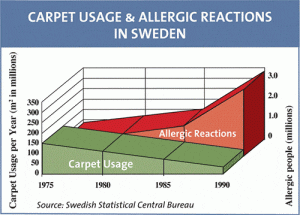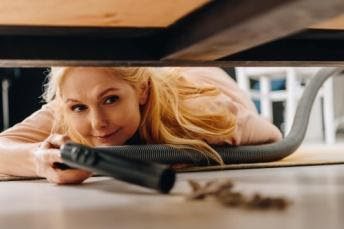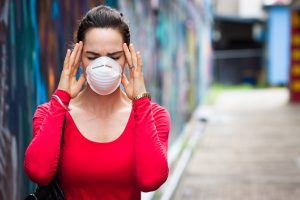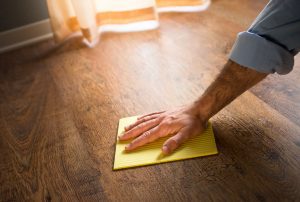Author: Kathy McClelland
Worried About Disinfecting Your Home?
Is all this craziness causing you to worry about the bacteria, viruses and germs in your home?
Have you asked the question: How long does the SARS-CoV-2 (The virus that causes the disease Covid-19) last on surfaces?
Data is constantly changing as research progresses:
As of March 18th, 2020, reports in New England Journal of Medicine suggest that SARS-CoV-2 can survive outside the human body in droplets for up to 3 hours. However, on plastic and stainless steel surfaces it can survive for 2-3 days.
In Journal of Hospital Infection, researchers found that a related coronavirus that causes SARS can persist up to 9 days on nonporous surfaces such as stainless steel or plastic.
On clothing and other surfaces harder to disinfect, it is not yet clear how long the virus can survive.
The ability of the virus to linger for so long underlines the importance of hand hygiene and the cleaning of surfaces.
One of the few encouraging aspects of the COVID-19 outbreak is that the virus is enveloped. Enveloped viruses are the easiest type to kill by disinfecting. The structure of these viruses includes a lipid envelope, which is easily compromised by most disinfectants. Once the lipid envelope is damaged, the integrity of the virus is compromised, thereby neutralizing its capacity to infect.
The EPA has suggested the use of the following products for disinfection:
“Flu viruses are killed by heat above 167° F (75° C). Common household cleaning products can also kill the flu virus, including products containing:
- Chlorine
- Hydrogen peroxide
- Detergents (soap)
- Iodophors (iodine-based antiseptics)
- Alcohols
If you or a family member, have been exposed to the flu, our cleaning processes can help prevent infection and re-infection.
Cleaning that favorite couch, chair or flooring in any room, where bacteria may be difficult to remove, is our specialty.
Our restorative cleaning process uses high heat and safe, approved cleaners – which can greatly reduce, or eliminate germs that cause sickness or re-infection.
We have enhanced our cleaning with a hospital safe, effective germicide which is not harmful to people or pets. It is made from plants and is totally green.
Call us at 417-833-1732 for more information.
Being safe and clean has always been our goal for our clients.
At Buddy’s Carpet Care we physically flush out and remove the germs and bacteria from your home and transport it directly to our waste tank. We also use routine cleaning precautions between each client to ensure our equipment stays clean and prevents cross-contamination.
Don’t be scared, Buddy’s Carpet Care is here and available 24/7. We can clean and disinfect almost any surface to help keep your home and business, healthy and clean.
Is Carpet Making My Allergies Worse?
Did you know?
FACT: The average 6 room home collects 40 pounds of dust each year. – (Discover Magazine)
FACT: 50% of all illnesses are either caused or aggravated by polluted indoor air. (American College of Allergists)
FACT: Most people spend 60-70% of their time indoors. (American Lung Association).
In the past Doctors and Allergists have suggested that the presence of carpet has a negative effect on the allergy or asthma sufferer. However, recent studies have shown that the weight of evidence no longer supports a link between carpet, asthma and allergy symptoms.
In fact, clean, dry, well-maintained carpet actually improves indoor air quality. Researcher and toxicology expert Mitchell Sauerhoff, Ph.D., DABT, reviewed 23 U.S. and international scientific studies and concluded in “Carpet, Asthma and Allergies – Myth or Reality“, that carpet’s alleged negative characteristics are not consistent with current research. In fact, he concludes that the literature on carpet and asthma or allergies confirms that children and adults living with carpet do not have an increased incidence of asthma or allergy.
“Based on the available science, carpet does not cause asthma or allergies and does not increase the incidence or severity of asthma or allergy symptoms. In fact multiple studies have reported fewer allergy and asthma symptoms associated with carpet.”
So weather you choose carpet, tile, or hardwood floors, the important part is to have a consistent and effective cleaning plan in place. Let Buddy’s Carpet Care help you maintain your clean home by scheduling an estimate today!

Hardwood Floors Lost Their Luster?
Hardwood floors are beautiful and can add thousands of dollars in value to a home, but only if they are well maintained.
- Dirt, sand and grit are major enemies of beautiful hardwood floors. Grit acts like sandpaper digging into the hardwood finish. Regular sweeping, vacuuming or using a clean dust mop are a must.
- Stains caused by water look dark and ugly. Be sure to wipe up any spills quickly.
- Use area rugs near doors and areas that have direct sunlight.
- Use felt protector pads on legs of your furniture.
- Try Buddy’s Hardwood Cleaning Service periodically to deep clean and renew that luster.
Immediate Damage Containment
What does Immediate Damage Containment mean?
The Immediate Damage Containment (IDC) consists of removing the excess water/sewage, decontamination and installing dehumidification. The Damage Containment has to be completed immediately to prevent further damage, contamination and expenses. Most insurance policies require the insured (yourself) to unilaterally initiate “reasonable and prudent procedures necessary to mitigate the loss.” In other words, to preserve, protect and secure the property from further water damage and reducing the overall claim cost. Therefore, if you have coverage for this type of loss, your insurance company can’t deny your claim because you have not followed your policy requirements for coverage. (However, structural drying and secondary damage containment may be also necessary within 12 hours of the water loss. Check your policy for the details.)
During the IDC, your technician will be blocking and tabbing your furniture and possessions and removing the excess water/sewage to prevent further damage. He/she will also be moving all of the contents to the middle of the room to prepare for structural drying and/or renovation.
Your technician has been specifically trained and equipped to physically remove as much water from your home or business as possible. The primary responsibility of your Immediate Damage Containment Technician is to do a basic floor inspection, chart the affected areas and recommend the safest and quickest way to remove the excessive water. He/She will also install Low-Grain Dehumidification. He/She will give you an upfront estimate ONLY for the immediate damage containment before he/she begins the water removal.
Can the Damage be Reversed?
Many items that look badly damaged may be able to be completely restored. Unfortunately, some items may be beyond restoration. However, in most cases, the damage can be avoided if the restorative drying process is begun without delay.
We can begin to reverse the effects of water damage by controlling where the water will “wick”. Wet will go to dry if it can, even if it is climbing up a wall. When high velocity commercial air movers (fans) are placed at the base of a wall that is wet, it can begin to reverse the wicking. Meaning as the air mover begins to dry the area directly in front of it; the near-by moisture begins to wick towards the new dry area. Remember, wet will go to dry if it can. Once that area is restored to its original moisture content, thereby preserving the structural integrity, the air mover is then moved to the next wet area.
Low-Grain, high temperature dehumidifiers are also placed in the affected area. These dehumidifiers remove the wet cold air and replace it with hot dry air. The hot dry air is then circulated to the air movers, which speeds up the drying process. Low-Grain simply means the unit puts out a much lower specific humidity or Grains of Moisture per pound than regular dehumidifiers. Our dehumidifiers remove the wet cold air and replace it with hot dry air. The hot dry air is then circulated to the air movers, which speeds up the drying process. Low-Grain simply means the unit puts out a much lower specific humidity or Grains of Moisture per pound than regular dehumidifiers. Our Grain depressions are as low as 28-30 grains per pound compared to that of your home air conditioning systems or your store bought dehumidifier which can produce as low as 60-65 grains per pound (specific humidity). The benefit for your, your home or business is that it dries within days rather than weeks or months. There is no chance for fungal growth. With the Phoenix and Injecti-dry System we can also dry structures such as hardwood floors, sill plates, sub-floors etc., that can’t be dried with the convectional refrigerant type dehumidifiers.
On average, we can dry the structure and contents of a saturated home or business in three to four days. 82% of the clean water damaged homes/businesses we dry, will need no repair at all, or only minor repairs such as spot painting and/or carpet cleaning. If additional repair is needed, Tuft Aide, Inc. has the qualified personnel to get the job done right!
Handy Repair Tips
Water damage can be a lot like an iceberg. You might only see the initial wet spots but the real damage is what’s underneath. It’s not easy to initially tell how far spread the damage really is. Unless taken care of right away, water damage can greatly reduce the value of your property, increase your insurance rates and negatively reduce your health. So the first thing you always want to do when a water disaster strikes is take immediate action.
Water needs to be extracted immediately before mold has a chance to grow. The humidity in the area may cause mold to grow on your furniture even if it hasn’t had direct contact with the water –this is why we recommend removing all the furniture from the affected areas until the humidity reaches normal levels again.
The next thing you need to do is report the water damage to your insurance provider. Never risk further damage to your belongings by trying to dry the structure yourself. If your insurance policy covers water damage, then this is the perfect time to take advantage of that! Have a professional come to assess what items are worth saving. Often times we can save areas that most construction companies would just tear out.
Go over every part of the house. Water damage can affect the whole house. It can affect the air quality, the drywall, the upholstery, carpeting, and even hardwood flooring. That is why it’s best to bring in the experts to inspect and give you their opinion in water damage repair. Here at Tuft Aide, Inc. we always take care of your wood flooring, tile, carpeting, air vent cleaning, and everything else. This way you only have to deal with one company, and not a variety of different services.
Are You Sure You’re Insured?
Homeowners buy insurance to protect against disaster. But when disaster strikes, your insurer might not live up to your expectations, especially if you have a large claim. These days, homeowners insurance covers less and costs more.
Insurers often use contract language to avoid paying claims. For example, got hail coverage? Great. But if your roof is more than 10 or 15 years old, hail damage might be excluded. Even if you have a standard homeowners policy that covers an overflowing bathtub or burst or frozen water pipe plus flood insurance, you’re still out of luck if your sump pump can’t handle a monster downpour or if the sewer backs up —unless you pay $40 to $50 a year more for a specific endorsement covering that.
You might not even be aware of the erosion in coverage until you file a claim. The average homeowner files a claim only once every 6 years, and many policyholders don’t read the disclosures, renewal contracts, and updates that insurers send them.
Outdated assumptions about your coverage can cost you a bundle. Don’t let that happen to you, call your insurance provider today before damage strikes.
Buddy suggest home owners should do the following to decrease their insurance costs!
1. Review Your Policy Limits Once a Year
You want your policy to cover any major purchases or additions to your home. But you don’t want to spend money for coverage you don’t need. Taking a few hours once a year to go over what is covered in your policy can make a big difference.
2. Make Your Home More Disaster Resistant
You may be able to save on your premiums by adding storm shutters, reinforcing your roof or buying stronger building materials. Update your heating, plumbing and electrical systems to reduce the risk of fire and water damage.
Water Damaged Sheetrock and Drywall
Water damage to sheet-rock and drywall is especially frustrating because, while it can be repaired, the cost to do so is often more expensive than the cost to replace it. Swelling and staining are common sins of water damage. If the drywall has been painted stains may not be readily apparent but will show through over time. Re-painting over damaged areas will not solve the problem.
Drywall and sheet-rock can usually be cut in a horizontal fashion, somewhere above the level of the damage and removed. You can replace it with an undamaged piece, prepare it and paint it. If you are less of a handy man and aren’t sure you can successfully hide the seam., then replace the whole piece. Either way, the end result will look much better than trying to patch it with a temporary fix.
Be sure that the wall cavity is dry and water free. Leaving water unattended in any area like this can make it a prime candidate for mold. Any water damaged insulation should be removed and replaced. Always avoid touching any moldy drywall. If you notice a mold growth, have a professional remove it for you. Be sure to wear a face mask when working around drywall products to prevent inhalation of dust chemicals, or other potentially harmful agents.
Have the Sniffles Got You Down?
Did you know mold allergies get worse during the winter? Indoor heat inside your house pulls air from the crawl space into the living space. Sometimes it’s hard to see the water damage, you may need a professional with a moisture meter and infrared cameras to see if there’s a leak.
What Are the Symptoms?
Symptoms of mold are very similar to other allergies, such as sneezing, itching, running nose, congestion and dry, scaling skin. Reactions worsen in a damp or moldy room such as a basement.
How to Prevent Mold and Mildew Inside Your Home
• Get your house tested for mold. A moisture meter test will help. Also, a dust sample from your carpet can show whether mold spores are in your home. Check with your state health department about mold testing.
• Fix leaky plumbing or other sources of water. If you have mold in your crawl space or basement, locate the source and stop the water from coming in.
If your crawl space has mold, call an environmental service to get rid of it. If a small area is moldy, you can try cleaning it yourself.
• Check inside drywall for mold inside the wall. You can usually smell mold even if you can’t see it. Moldy drywall must be cut out and replaced. Moldy insulation also must be removed and replaced.
• Wash mold off hard surfaces. You don’t have to use chlorine bleach; soap and water, combined with scrubbing from a stiff brush, works to remove mold. Some people also recommend vinegar or hydrogen peroxide. Non-toxic cleaners are also available. Allow areas to dry completely.
• Dry water-damaged areas and items (like carpeting) within 24 to 48 hours of flooding. Don’t install carpeting in areas where there is a moisture problem.
• If ceiling tiles or carpet have become moldy, they must be replaced. Throw out all wet, moldy tiles and carpeting.
• Reduce indoor humidity by venting bathrooms, dryers, and other moisture-generating sources. Exhaust fans in bathrooms and kitchens can help. If you don’t have exhaust fans, crack a window in the kitchen when you’re cooking or in the bathroom when you’re bathing.
• Use air conditioners and dehumidifiers inside your home. Change filters regularly. Use a dehumidifier to get rid of dampness in basements.
• Add insulation to windows, piping, exterior walls, roof, or floors where there is potential for condensation on cold surfaces.
 About 60% of dust comes from outside. Soil, Pollen and other outdoor containments can come inside on your shoes, clothes, even your hair. The other 40% come from dust mites (the more dust you have the more dust mites you have), pet dander, dead skin, food debris, insects and insect droppings, lead, arsenic and DDT.
About 60% of dust comes from outside. Soil, Pollen and other outdoor containments can come inside on your shoes, clothes, even your hair. The other 40% come from dust mites (the more dust you have the more dust mites you have), pet dander, dead skin, food debris, insects and insect droppings, lead, arsenic and DDT.


